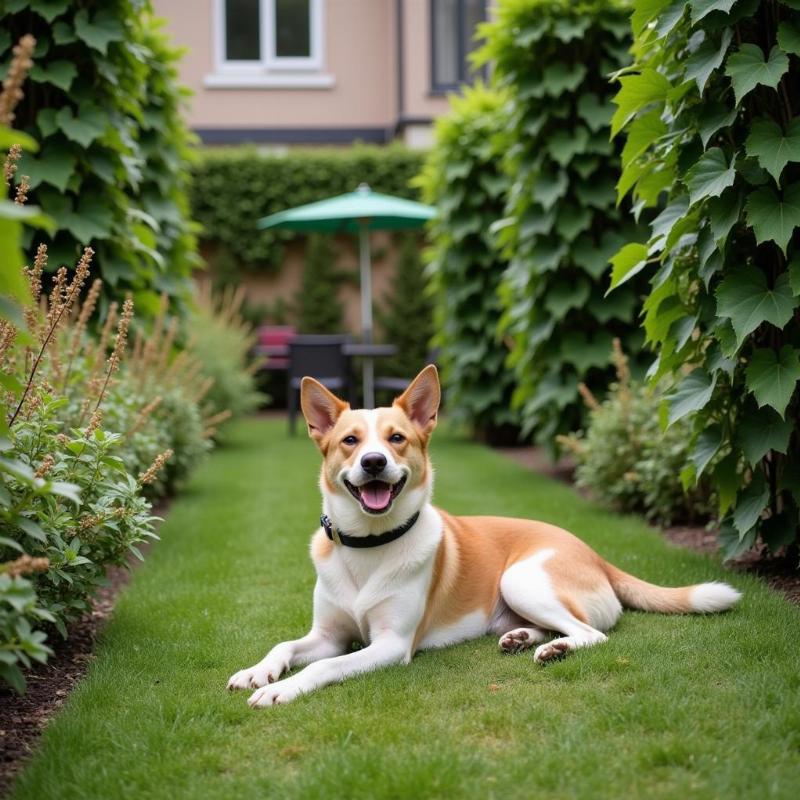Keeping your furry friend safe and your garden beautiful can be a challenge. Many dogs love exploring the outdoors, nibbling on plants included, which makes selecting dog-safe landscaping crucial. If you’re envisioning a lush vertical garden with climbing vines, you’ll want to ensure those vibrant additions won’t harm your canine companion. This guide explores climbing vines safe for dogs, helping you create a beautiful and worry-free outdoor space for both you and your beloved pet.
Choosing Non-Toxic Climbing Vines
The ASPCA’s Animal Poison Control Center (APCC) is a valuable resource for identifying plants toxic to pets. Cross-referencing your vine choices with their database can prevent potential hazards. Fortunately, many beautiful and vigorous climbing vines pose no threat to dogs.
Some excellent dog-safe choices include:
- Crossvine (Bignonia capreolata): This native vine boasts beautiful trumpet-shaped flowers and is a favorite among hummingbirds.
- Trumpet Honeysuckle (Lonicera sempervirens): Another hummingbird attractor, this vine offers fragrant, colorful blooms.
- American Wisteria (Wisteria frutescens): While the seeds can be toxic in large quantities, the vine itself is generally considered safe for dogs, and its cascading lavender flowers are a stunning addition to any garden.
Avoiding Toxic Vines: Protecting Your Pup
Several popular climbing vines are toxic to dogs and should be avoided entirely. English Ivy, while visually appealing, can cause gastrointestinal upset if ingested. Similarly, Morning Glory and Clematis, known for their vibrant flowers, can also be harmful to your dog.
- English Ivy (Hedera helix): This common vine can cause vomiting, diarrhea, and abdominal pain in dogs.
- Morning Glory (Ipomoea spp.): Ingestion can lead to hallucinations, tremors, and even liver failure in severe cases.
- Clematis (Clematis spp.): This popular flowering vine can cause mouth irritation and drooling if chewed on by your dog.
Building Your Dog-Friendly Vertical Garden
Creating a dog-friendly vertical garden goes beyond selecting safe plants. Consider your dog’s habits and activity level. If your dog is a digger, you might need to protect the base of your vines with chicken wire or rocks. Durable trellises are essential for supporting the vines and preventing them from becoming a tempting chew toy.
Training and Supervision: A Two-Pronged Approach
Even with non-toxic plants, it’s best to discourage your dog from chewing on your garden. Training, such as teaching the “leave it” command, can be incredibly helpful. Supervision, especially for puppies or dogs known to nibble on greenery, is crucial for preventing accidental ingestion.
Why Are Some Vines Toxic?
Many toxic vines contain compounds that disrupt a dog’s digestive system or other bodily functions. The severity of the reaction can vary depending on the plant, the amount ingested, and the individual dog’s sensitivity. If you suspect your dog has ingested a toxic plant, contact your veterinarian or the ASPCA’s APCC immediately.
 A Dog Enjoying a Safe Garden with Non-Toxic Vines
A Dog Enjoying a Safe Garden with Non-Toxic Vines
Conclusion: A Beautiful and Safe Oasis
Creating a dog-friendly vertical garden is entirely achievable. By carefully selecting non-toxic climbing vines, implementing preventative measures, and providing proper training and supervision, you can cultivate a beautiful and safe outdoor space where both you and your furry friend can thrive. Remember to always consult with your veterinarian or the ASPCA’s APCC if you have any concerns about plant toxicity.
FAQ
- What should I do if my dog eats a potentially toxic vine? Contact your veterinarian or the ASPCA Animal Poison Control Center immediately.
- Are all parts of a vine equally toxic? Toxicity can vary between different parts of the same plant. It’s best to assume the entire plant is potentially harmful.
- How can I train my dog to stay away from my plants? Positive reinforcement training methods, like teaching the “leave it” command, can be very effective.
- Are there any dog-safe alternatives to toxic climbing vines? Yes, there are many beautiful and vigorous non-toxic climbing vines available. Consult with your local garden center for recommendations.
- What kind of trellis is best for a dog-friendly garden? Choose a sturdy trellis that can withstand your dog’s activity level and won’t easily break or become a chew toy.
- Can I use fertilizers and pesticides in a dog-friendly garden? Opt for pet-safe fertilizers and pesticides. Always follow the product instructions carefully.
- How can I make my entire garden dog-friendly? Choose dog-safe plants, provide shade and water, and create designated areas for digging and playing.
Beautdogs.us is your premier source for comprehensive dog care information, breed insights, and top-quality product recommendations. We cater to both new and experienced dog owners, offering expert advice and practical tips to help you navigate the world of canine companionship. From understanding your dog’s nutritional needs to creating a safe and stimulating environment, Beautdogs.us is your trusted partner in providing the best possible care for your furry friend. Connect with us for personalized support at [email protected] or call us at +1 501-555-7529.